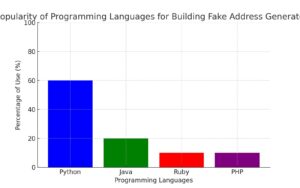A fake address generator is useful for developers who need mock data for testing or when privacy matters in app development. Tools like Faker, Fake Address Generator, and Chance provide an easy way to create reliable fake addresses.
These tools help developers save time and ensure their data is accurate for testing purposes. Using them can make developing applications that handle personal information much smoother.
Choosing the Right Programming Language for Your Generator
Understanding Fake Address Generators

Fake address generators are software tools that generate fictitious but realistic data for various purposes. They are commonly used in software testing, data analysis, and research. The generated data can be used to test software applications, databases, and systems, as well as to conduct research and analysis without compromising the privacy of real individuals.
The Role of Fake Data in Software Testing
Fake data is an essential component of software testing. It allows developers to test their applications and systems with realistic data without compromising the privacy of real individuals. With fake data, developers can simulate different scenarios and test the functionality of their applications and systems under various conditions. This helps to ensure that the applications and systems are robust, reliable, and secure.
Privacy Protection and Data Privacy Laws
Data privacy is a significant concern in today’s digital world. With the increasing amount of personal data being collected and stored by organizations, privacy protection has become more critical than ever. Fake address generators can help protect the privacy of individuals by providing realistic but fictitious data that can be used for testing and analysis without compromising the privacy of real individuals.
However, it is essential to note that data privacy laws and regulations vary by country and region. Organizations must comply with these laws and regulations when collecting, storing, and using personal data. Failure to comply with these laws can result in significant legal and financial consequences. Therefore, it is crucial to ensure that the use of fake address generators complies with applicable data privacy laws and regulations.
Designing the Address Generation Algorithm

Generating fake addresses requires a well-designed algorithm that incorporates randomness and authenticity to produce realistic addresses. The algorithm should also provide customization options for different use cases.
Incorporating Randomness and Authenticity
The first step in designing the address generation algorithm is to incorporate randomness and authenticity. A good fake address generator should produce addresses that look real and diverse, suitable for a variety of use cases.
To achieve this, the algorithm should randomly generate different components of the address, such as countries, cities, street names, and postal codes. The algorithm should also ensure that the generated addresses are consistent with the format and structure of real addresses.
Customization Options for Different Use Cases
Another important aspect of the address generation algorithm is to provide customization options for different use cases. For example, some users may require addresses from specific countries or regions, while others may need addresses with certain characteristics, such as rural or urban areas.
To provide customization options, the algorithm should allow users to specify the country, state, city, and other components of the address. The algorithm should also provide options for users to customize the format and structure of the address, such as the use of abbreviations or full names for street names, or the inclusion of apartment or unit numbers.
Implementing the Generator with Software Tools
Developing a fake address generator requires a combination of programming languages, libraries, and APIs. The following subsections discuss the different software tools that can be used to implement the generator.
Selecting Programming Languages and Libraries
The choice of programming language depends on the developer’s preference, but some popular languages for software development include Python, Java, and Ruby. Libraries such as Faker, which is a Python library, can be used to generate fake data, including addresses. Faker provides a range of functions to generate different types of data, such as names, addresses, and phone numbers.
Integrating APIs for Enhanced Functionality
APIs can be integrated into the fake address generator to enhance its functionality. For example, the Google Maps API can be used to validate the generated addresses and ensure that they are real addresses. Another useful API is the REST Countries API, which can be used to generate addresses based on different countries and their formats.
Database and Data Format Considerations
The fake address generator can store the generated data in a database for future use. The choice of the database depends on the developer’s preference, but popular databases include MySQL, PostgreSQL, and MongoDB. The data can be stored in different formats such as JSON or CSV. Git can be used to manage the codebase and track changes made to the generator.
Testing and Deploying the Generator

After developing a fake address generator using software tools, it is crucial to test and deploy the application to ensure its quality and accessibility to users. In this section, we will discuss the two important aspects of testing and deployment.
Quality Assurance and Application Testing
Quality assurance and application testing are crucial steps in the development process of any software application. It involves testing the application to ensure that it meets the required standards and specifications. In the case of the fake address generator, it is essential to test the application to ensure that it generates accurate and valid addresses.
Furthermore, the tester should also test the application for any bugs or errors that may affect its performance. The tester should use different scenarios to test the application, such as generating multiple addresses simultaneously, generating addresses for different countries, and testing the application’s response time.
Deployment Strategies and User Accessibility
After testing the application, the next step is to deploy it to make it accessible to users. The developer should consider various deployment strategies, such as cloud-based deployment or on-premise deployment, depending on the application’s requirements.
The developer should also ensure that the application is user-friendly and easy to use. The application’s interface should be intuitive and straightforward, and the user should be able to generate addresses with minimal effort. The application should also provide clear instructions on how to use it, and the user should be able to generate addresses for different countries easily.











